

Chapter 54 - Ecosystems. Biology. Spectrum WebScope: Histology. Spectrum WebScope: Histology\Basic Tissues\Epithelium and CT. Small and Large Intestine. The histology of the wall of the small intestine differs somewhat in the duodenum, jejunum, and ileum, but the changes occur gradually from one end of the intestine to the other. 1.
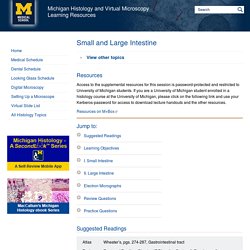
DuodenumSlide 162 40x (pyloro-duodenal junct, H&E) WebScope (link is external) ImageScopeSlide 161 40x (pylorus, duodenum, pancreas, H&E) WebScope (link is external) ImageScope.
Mammalia. Botany. 5 dna structure worksheet in Cell - Biological Science Picture Directory - Pulpbits.net. Our body includes approx ONE HUNDRED Trillion cells one of them is 5 Dna Structure Worksheet The health and wellness of our body depends on the health and wellness of our cells. health and wellness.
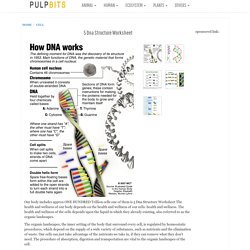
The Cell Cycle & Mitosis Tutorial. Plant & Animal Cells Lapbook. Microscopy. Cas9. CRISPR-Based Genome Editing Support—Getting Started. As a simple two-component system that includes the Cas9 endonuclease and a noncoding guide RNA (gRNA), the engineered Type II CRISPR/Cas system can be leveraged to cleave genomic DNA at a predefined target sequence of interest.

The gRNA has two molecular components: a target-complementary CRISPR RNA (crRNA) and an auxiliary trans-activating crRNA (tracrRNA). Both the gRNA and the PAM (NGG) motif guide the Cas9 nuclease to a specific genomic sequence to form a complex, followed by local strand separation (R-loop), at which the Cas9 nuclease creates a double-stranded DNA break (DSB) 3 nucleotides upstream from the PAM site. As a result, you may bring new functionality to the gene of interest via mutations, create knockouts, or introduce nonnative or synthetic genomic sequences to investigate novel applications. CRISPR also allows for non-editing application flexibility such as gene regulation or RNAi-related studies. Quick Learning Of Crispr Cas9 - 17 January 2015.
Grna constructs for crispr cas9 genome editing crispr cas9 mediated genome editing powerful technique that allows you create knock knock out and mutation any gene any cell highly targeted.

News and insights jackson laboratory news and insights gain insights into bioscience technology and the quest improve human health. Gene knockdown wikipedia the free encyclopedia external links tools and information for crispr use talen design help more talen tools. Editing humanity the economist dizzying range applications has researchers turning crispr develop therapies for everything from alzheimer cancer hiv see article. Editing humanity the economist dizzying range applications has researchers turning crispr develop therapies for everything from alzheimer cancer hiv see article. Crispr services crispr cas9 resources genscript highlights crispr cas9 additional foreign dna introduced the targeted gene region simpler and more efficient method gene editing pared zfns and.
CRISPR - gene-editing for everyone. Figure 1 : Cell division : Nature. A, Prophase.
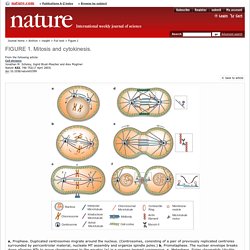
Duplicated centrosomes migrate around the nucleus. (Centrosomes, consisting of a pair of previously replicated centrioles surrounded by pericentriolar material, nucleate MT assembly and organize spindle poles.) b, Prometaphase. VCAC: Cellular Processes: Electron Transport Chain: The Movie. Electron transport chain and Oxidative phosphorylation. Lecture Notes. October 24, 2013 Introduction We began by reviewing our introduction to levels of regulation in bacterial gene expression from last time.

Cells can regulate transcription or translation, or regulate proteins post-translationally. 29 105 fa13 control of gene expression prokaryotes skel. File:MRNA.svg. Cancel Edit Delete Preview revert.

Prokaryotic Cells. Background Prokaryotic Cell Structure Prokaryotes are simple organisms that contain no membrane bound organelles.
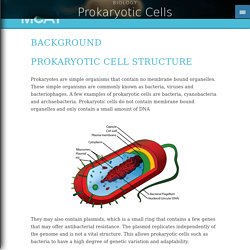
These simple organisms are commonly known as bacteria, viruses and bacteriophages. A few examples of prokaryotic cells are bacteria, cyanobacteria and archaebacteria. Prokaryotic cells do not contain membrane bound organelles and only contain a small amount of DNA. The most direct way to control the expression of a gene is to regulate its rate of transcription; that is, the rate at which RNA polymerase transcribes the gene into molecules of messenger RNA (mRNA)
The Lac operon, an example of a transcriptionally regulated system.
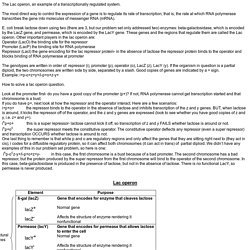
The most direct way to control the expression of a gene is to regulate its rate of transcription; that is, the rate at which RNA polymerase transcribes the gene into molecules of messenger RNA (mRNA). E. coli break lactose down using two (there are 3, but our problem set only addressed two) enzymes: beta-galactosidase, which is encoded by the LacZ gene, and permease, which is encoded by the LacY gene. These genes and the regions that regulate them are called the Lac operon. Other important players in the lac operon are: Operator (LacO) the binding site for the repressor. Regulation of Gene Activity and Gene Mutations. 15.1 Prokaryotic Regulation Bacteria do not require the same enzymes all the time; they produce just those needed at the moment.

Francois Jacob and Jacques Monod (1961) proposed the operon model to explain regulation of gene expression in prokaryotes. In the operon model, several genes code for an enzyme in the same metabolic pathway and are located in a sequence on a chromosome; expression of structural genes is controlled by the same regulatory genes. Griffiths introduction to genetic analysis 10th textbook . contact fo… Flavin adenine dinucleotide. Kilocalorie - Biology-Online Dictionary. Definition noun, plural: kilocalories A measure of heat energy that is equal to the amount of heat needed to raise the temperature of one kilogram of water by one degree Centigrade at one atmospheric pressure. Supplement It is used in measurements of the heat production of chemical reactions, including those involved in biology.
Reporter gene fusions. Ambros, V. (2004). The functions of animal microRNAs. Nature 431, 350–355. Abstract Article Chalfie, M., Y. Tu, et al. (1994). Dupuy, D., Li, Q.R., et al. (2004). Plasmids. It is often desirable to maintain two different plasmids in a single cell. What are two important considerations when choosing the plasmids to use? Bacterial transformation. Amazing bacteria Bacteria are incredibly versatile organisms that have the unique ability to take in foreign DNA and replicate (or copy) it. This gives them an evolutionary advantage and helps them survive changes in their environment. For example, bacteria can acquire DNA that makes them resistant to antibiotics. The bacterial genome is contained on a single, circular chromosome. This genetic material floats freely in the cell, unlike eukaryotic organisms where the genetic material is enclosed within a nuclear membrane.
Bacteria may sometimes contain smaller circles of DNA, called plasmids, which have a much smaller number of genes. Carolina Booklet. Bacteriology: Bacillus.
Heart Labeling (KEY) OpenStax CNX - Content Library. Explore Geobiology Resources. Spectrophotometry.pdf. Water Quality Photometers and Colorimeters Information on GlobalSpec. Image credit: Hach | StellarNet, Inc. | HF scientific Water quality photometers and colorimeters are instruments designed to determine the concentration of a solution from its color density. Colorimetric Analysis Colorimetry is a widely-used, effective method for testing water quality. This process involves adding a chemical reagent to a water sample to be measured. Taxonomy. Virtuallabs.html. Fungi. Home. Learn.Genetics.utah.edu.
DNA. Cell energy cycle. Cells. Membrane. Organelles. General GUIDES. Molecules. Chemistry. Labs.